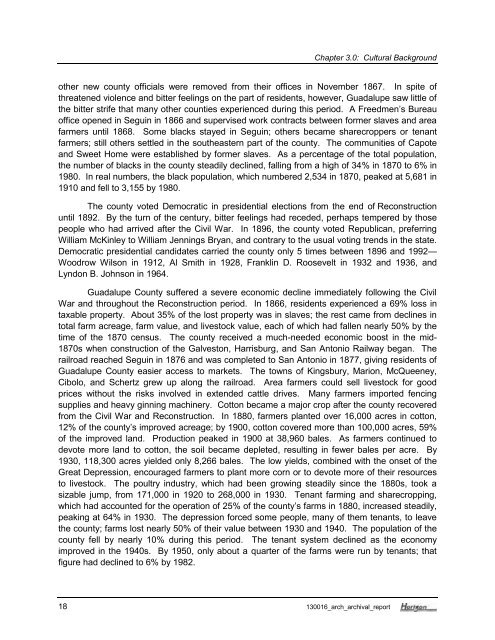Guadalupe Generating Station Final Cultural Resourse Report - US ...
Guadalupe Generating Station Final Cultural Resourse Report - US ...
Guadalupe Generating Station Final Cultural Resourse Report - US ...
You also want an ePaper? Increase the reach of your titles
YUMPU automatically turns print PDFs into web optimized ePapers that Google loves.
Chapter 3.0: <strong>Cultural</strong> Background<br />
other new county officials were removed from their offices in November 1867. In spite of<br />
threatened violence and bitter feelings on the part of residents, however, <strong>Guadalupe</strong> saw little of<br />
the bitter strife that many other counties experienced during this period. A Freedmen’s Bureau<br />
office opened in Seguin in 1866 and supervised work contracts between former slaves and area<br />
farmers until 1868. Some blacks stayed in Seguin; others became sharecroppers or tenant<br />
farmers; still others settled in the southeastern part of the county. The communities of Capote<br />
and Sweet Home were established by former slaves. As a percentage of the total population,<br />
the number of blacks in the county steadily declined, falling from a high of 34% in 1870 to 6% in<br />
1980. In real numbers, the black population, which numbered 2,534 in 1870, peaked at 5,681 in<br />
1910 and fell to 3,155 by 1980.<br />
The county voted Democratic in presidential elections from the end of Reconstruction<br />
until 1892. By the turn of the century, bitter feelings had receded, perhaps tempered by those<br />
people who had arrived after the Civil War. In 1896, the county voted Republican, preferring<br />
William McKinley to William Jennings Bryan, and contrary to the usual voting trends in the state.<br />
Democratic presidential candidates carried the county only 5 times between 1896 and 1992—<br />
Woodrow Wilson in 1912, Al Smith in 1928, Franklin D. Roosevelt in 1932 and 1936, and<br />
Lyndon B. Johnson in 1964.<br />
<strong>Guadalupe</strong> County suffered a severe economic decline immediately following the Civil<br />
War and throughout the Reconstruction period. In 1866, residents experienced a 69% loss in<br />
taxable property. About 35% of the lost property was in slaves; the rest came from declines in<br />
total farm acreage, farm value, and livestock value, each of which had fallen nearly 50% by the<br />
time of the 1870 census. The county received a much-needed economic boost in the mid-<br />
1870s when construction of the Galveston, Harrisburg, and San Antonio Railway began. The<br />
railroad reached Seguin in 1876 and was completed to San Antonio in 1877, giving residents of<br />
<strong>Guadalupe</strong> County easier access to markets. The towns of Kingsbury, Marion, McQueeney,<br />
Cibolo, and Schertz grew up along the railroad. Area farmers could sell livestock for good<br />
prices without the risks involved in extended cattle drives. Many farmers imported fencing<br />
supplies and heavy ginning machinery. Cotton became a major crop after the county recovered<br />
from the Civil War and Reconstruction. In 1880, farmers planted over 16,000 acres in cotton,<br />
12% of the county’s improved acreage; by 1900, cotton covered more than 100,000 acres, 59%<br />
of the improved land. Production peaked in 1900 at 38,960 bales. As farmers continued to<br />
devote more land to cotton, the soil became depleted, resulting in fewer bales per acre. By<br />
1930, 118,300 acres yielded only 8,266 bales. The low yields, combined with the onset of the<br />
Great Depression, encouraged farmers to plant more corn or to devote more of their resources<br />
to livestock. The poultry industry, which had been growing steadily since the 1880s, took a<br />
sizable jump, from 171,000 in 1920 to 268,000 in 1930. Tenant farming and sharecropping,<br />
which had accounted for the operation of 25% of the county’s farms in 1880, increased steadily,<br />
peaking at 64% in 1930. The depression forced some people, many of them tenants, to leave<br />
the county; farms lost nearly 50% of their value between 1930 and 1940. The population of the<br />
county fell by nearly 10% during this period. The tenant system declined as the economy<br />
improved in the 1940s. By 1950, only about a quarter of the farms were run by tenants; that<br />
figure had declined to 6% by 1982.<br />
18 130016_arch_archival_report
















